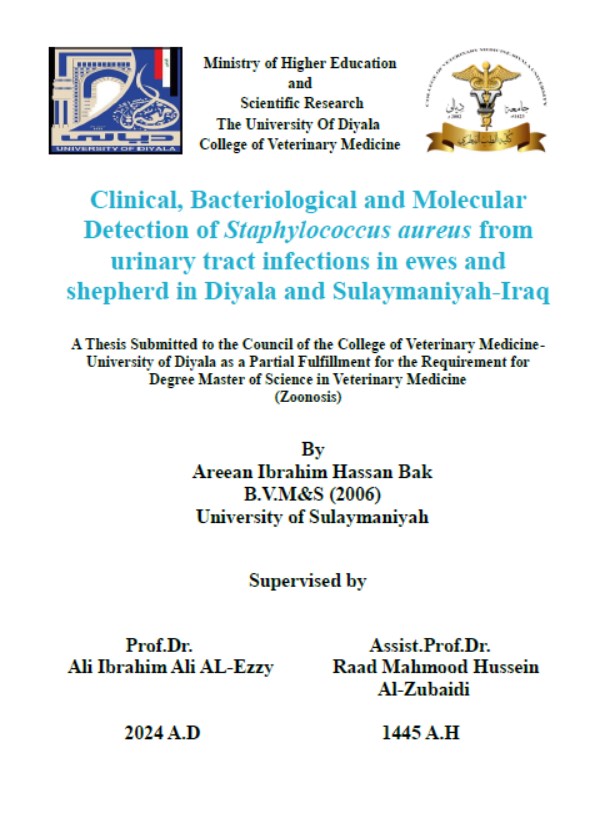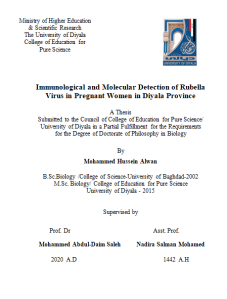Summary
In this study a total of 120 urine samples were collected from shepherds (49) and ewes (71) who suffered from urinary tract infections from the first of October 2022 to March 2023 in Sulaymaniyah province (Kalar district and surrounding villages) and Diyala province (Khanaqin district, villages of Qoratu district). Using Mannitol salt agar (as selective media) and employing traditional laboratory methods in addition to confirmatory techniques by the Vitek 2 system and conventional PCR, using specific primers (Staur 4, 6), and MRSA gene primers (mecA). Conventional PCR was used for the detection of Staphylokinase (sak), Lipase (geh), Intracellular Adhesion (IcaA), and protease (SSPA) genes.
Results:
The study includes (49) shepherds and (71) ewes suffering from clinical signs of urinary tract infections. A total of 27/49 (55.10%) of urine specimens give positive urine culture among shepherds, versus 35/71 (49.29%) among ewes. A total of 62 bacterial isolates were diagnosed primarily as S. aureus by traditional culture on mannitol salt agar and standard biochemical tests, but with further investigation with Vitek 2 system and conventional PCR using specific gene S.aureus 23srRNA primers (Staur 4, Staur 6). S. aureus was reported in 3/62 (4.83%), among shepherds, versus 7/62 (11.29%) among ewes with clinical manifestations of urinary tract infections.
S. equorum and S. haemolyticus detected in 8 out of 62 (12.90%). S. xylosus, S. warneri, S. gallinarum, S. arlettae, Enterococcus faecalis detected in 1 out of 62 bacterial isolates (1.61%) among shepherds. S. warneri, S .cohnii ssp, Urealyticus, Alloiococcus otitis, Aerococcus viridans detected in 1 out of 62 bacterial isolates (1.61%) among ewes with clinical manifestations of UTI.
S. aureus was reported mainly among shepherds in the age group (3–12 years). “A significant positive correlation was reported between age and infection with S. aureus. While in ewes S.aureus was reported mainly among age group (12–16) month. “No significant positive correlation was reported between the age of ewes and infection with S. aureus or non-S.aureus bacterial spp”.
There was no correlation between clinical signs of urinary tract infection among shepherdsand infection with S. aureus and infection with non-S.aureus except with the urge to urinate (p value =0.048). “A significant negative correlation was reported between cloud urine as a clinical sign of infection among shepherds and negative urine culture, (p value = 0.037)”.
There was no correlation between clinical signs of urinary tract infection among ewes and infection with S. aureus, non-S.aureus, or even a negative urine culture. No significant correlation was reported between the physical parameters of urine forshepherds and the isolation of S. aureus and non-S.aureus pathogens. “A significant correlation was reported between the appearance of urine inewes and the isolation of S. aureus (P value = 0.011)”.
“No significant correlation was reported between the biochemical parameters of urine for shepherds and the isolation of S. aureus and non-S.aureus pathogens”.
MecA gene, staphylokinase, lipase gene, intracellular adhesion gene (IcaA), protease gene (SSPA) gene were detected by conventional PCR in all S. aureus isolated from shepherds (3/3, 100%) and ewes (7/7, 00%) suffering from UTI. The Luks-PV-PVne was detected in 1/7 (14.28%) of S. aureus isolated from ewes. All S. aureus isolates from shepherds have negative detection for the Luks-PV gene.
A total of 3/3 (100%) of S. aureus isolated from shepherds have resistance to the following classes of antibiotics: penicillins and cephalosporins, and methicillin resistance was detected by the cefoxitin screen test and confirmed early by the detection of the MecA gene.Resistance of S. aureus to polypeptide antibiotics was detected at 3/3,100% for Vancomycin and 2/3, 66% for Teicoplanin. S. aureus isolated from shepherds have an absolute sensitivity of 3/3 (100%) for the following classes: aminoglycosides, quinolones, macrolides, lincosamides, oxazolidinone, tetracyclines, nitrofuran antibiotics, fusidanes, ansamycins, and sulfonamides. A total of 1/3, 33% of S. aureus was sensitive to the polypeptide class, teicoplanin.
All S. aureus isolated from Ewes 7/7 (100%) have resistance to penicillins, cephalosporins, and methicillin. Resistance was detected by a cefoxitin screen test and confirmed early by detection of the MecA gene by conventional PCR.Resistance of S. aureus to polypeptide antibiotics was detected in 7/7,100% for vancomycin and 6/7 (85.72%) for teicoplanin. Resistance of S. aureus to macrolide antibiotics was detected in 1/7 (14.28%) for azithromycin. Resistance of S. aureus to Lincosamide antibiotics, Clindamycin, was detected in 1/7 (14.28%). S. aureus isolated from ewes has an absolute sensitivity of 7/7 (100%) for the following classes: aminoglycosides, quinolones, macrolides (erythromycin), oxyazolidinone, tetracyclines, nitrofuran antibiotics, Fusidane, Ansamycins, and sulfonamides.





